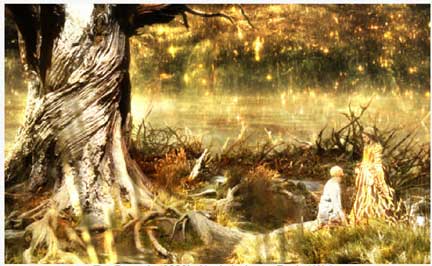
Publicity still from The Fountain, 2006
I wasn’t all that excited to see Darren Aronofsky’s new film The Fountain until I started reading press about the film. An article by Steve Silberman in the November 1 issue of Wired briefly mentions the father-son team, Peter and Chris Parks, responsible for the effects:
Parks and his son run a home f/x shop based on a device they call the microzoom optical bench. Bristling with digital and film cameras, lenses, and Victorian prisms, their contraption can magnify a microliter of water up to 500,000 times or fill an Imax screen with the period at the end of this sentence. Into water they sprinkle yeast, dyes, solvents, and baby oil, along with other ingredients they decline to divulge.
This is already such a delightful scene – kitchen alchemy, with Victorian prisms, no less – that it was nearly too much when I discovered the Parks’ studio is a 400-year-old stone building in the Cotswolds. How could this not be good stuff?
It turns out that Peter Parks has already won three Academy Awards (1982, 1987, 2004) for his technical contributions to film arts. He also worked on the Superman movie with Chris Reeve. In an interview with Jennifer Hough, Chris Parks said,
My father and I are known in the business for being able to create a unique kind of special effect. This latest project was a sci-fi movie where the director, (Darren Aronofsky) wanted to move away from digital effects to something more organic and real.
You can view the Fountain trailer here or here. I can’t say the plot sounds completely sensible, but the cinematography is beautiful. The effects I see in the trailer (alas, they only give us one full-length version) do look organic. And there are many more images and short films at Chris Parks’ own website which are pretty amazing, if a little grainy (which could well be the image file resolution – the larger trailers seem less so).
One of the problems with digital art, and a reason I shy away from it myself, is that it’s hard to generate organic randomness digitally. I love spontaneous textures, and in traditional media like watercolor, they’re pretty simple to create with spatter, salt, water, wax resist, or pairs of pigments that react in unexpected ways. It’s far more difficult to discipline the randomness than to generate it.
Good digital artists can also create random textures (textures that appear random, at least) but paradoxically, it takes a lot of effort to make it look unplanned. When I hear that a movie has “bad” effects, I think of scenes that are just too clean. We are disturbed by something unnaturally smooth or symmetrical, even if we can’t articulate what the giveaway is. Perhaps because our brains devote so much attention to them, faces may be the hardest effects to convincingly synthesize – check out this Wired News article by Clive Thompson on the “uncanny valley” where photorealism begins to seem downright creepy!
That’s why I love the idea of the Parks’ work. They don’t have to reverse engineer reality, because their effects are reality – microrealities captured photographically and substituted for larger, nebula-sized events.
Incidentally, the Parks team has made a reputation for their BBC-style nature documentary photography, but Chris Parks, who has degrees in both design and engineering, seems to feel the need to keep the “science” label off his more artistic efforts. From the interview: “I want people to approach the paintings like they would another piece of art, rather than as a scientific photograph.”
I don’t see any reason why they can’t be both, but I can understand where he’s coming from. I guess that’s one thing the Parks’ effects and digital effects have in common – trouble qualifying as mainstream “art.”
I’m eager to see if my own brain accepts the Parks’ art more readily than the recent uncanniness of Superman Returns. And I hope this means that ten years from now, The Fountain won’t end up looking dated in the embarassing manner of other, once-state-of-the-art films. Of course that’s assuming The Fountain is good enough that people will still be ordering it from Netflix ten years from now – which depends much more on director Aronofsky than the Parks. I’ll keep my fingers crossed.
